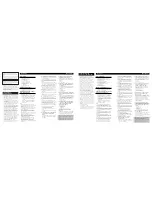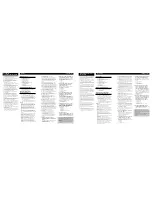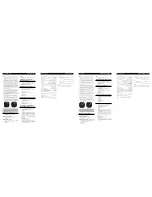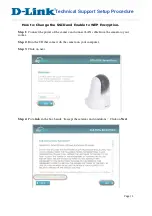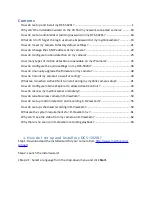
podría salpicar sobre la misma. (Para evitar el
riego de fallos de funcionamiento producidos por
las altas temperaturas, evite la instalación en los
lugares arriba.)
• Antes de taladrar cualquier orificio de montaje
siempre compruebe lo que hay detrás en donde
desea taladrar los orificios. No taladre en la línea
de combustible, cableado eléctrico u otras partes
importantes.
• Si esta unidad es instalada en el compartimiento
de pasajeros, fíjela seguramente de modo que no
se desprenda mientras el automóvil se encuentra
en movimiento, y pueda ocasionar lesiones o
accidentes.
• Si esta unidad se instale bajo un asiento delantero,
cerciórese de que no obstruye el movimiento del
asiento. Pase todos los cables y conductores
cuidadosamente a través de los mecanismo
deslizantes, de modo que no queden aprisionados
o atrapados en el mecanismo y ocasionen un corto
circuito.
• Encuentre la posición que desea instalar la cámara
de vista posterior. Ajuste el ángulo de la cámara
de vista posterior, e instale de modo que la cámara
no toque el coche.
• Cuando fije a una superficie de vídeo, fíjela en
una posición que asegure que la cámara no toque
la ventana trasera.
• Instale de modo que no obstruya el campo de
vista trasero.
• Instale de modo que no se sobresalga del lado del
coche.
• No realice la instalación en la lluvia o niebla.
• Cuando la humedad está alta, seque la superficie a
la cual fijará la unidad antes de instalar. La
humedad de la superficie de fijación reduce la
resistencia de adherencia, lo que puede soltar la
unidad.
• Si la temperatura de la superficie de fijación está
baja, caliente con un secador de pelo u otro medio
antes de instalar, para mejorar la resistencia de
adherencia.
• No fije el soporte de la cámara en áreas en la
carrocería del coche tratadas con resina de
fluorocarburo, o vidrio. Esto puede resultar en la
caída de la cámara de vista posterior.
• Durante el período de 24 horas tras la instalación:
– No aplique agua a la unidad.
– No exponga la unidad a la lluvia.
– No sujete la cámara a la fuerza innecesaria.
• Limpie completamente el sitio donde se utilizará
la cinta para fijar la unidad.
1. Limpie la superficie a la cual se
instalará la cámara de vista
posterior. (Fig. 3)
Utilice un paño u otro ítem para limpiar el
aceite, cera y cualquier otra suciedad de la
superficie de instalación.
2. Alinee el soporte de la cámara con
la superficie de instalación. (Fig. 4)
Ajuste el soporte de la cámara de modo
que no quede ningún espacio entre ello y
la superficie de instalación.
1
Gire
2
Retuerza
3
Soporte de la cámara
3. Fije la cámara de vista posterior al
soporte de la cámara con los
tornillos de instalación. (Fig. 6)
Dependiendo del lado que desea que el
cable salga, páselo a través de la ranura.
1
Parte superior
2
Cámara de vista posterior
3
Parte inferior
4
Tornillo de instalación
5
Soporte de la cámara
4. Quite la hoja de la parte posterior
del soporte de la cámara y fije.
(Fig. 5, Fig. 7)
Presione el soporte de la cámara con los
dedos para fijarlo en la superficie de insta-
lación. Tocar la superficie adhesiva o fijar
la unidad una segunda vez reduce la
resistencia de adherencia, lo que puede
resultar en el despegamiento de la unidad.
1
Soporte de la cámara
2
Fije en el centro
5. Ajuste el ángulo de modo que el
parachoques o borde trasero del
coche se visualice en la parte inferior
de la pantalla de TV. (Fig. 8, Fig. 9,
Fig. 10)
1
Ángulo de visión
Horizontal: 112°
2
Ángulo de visión
Vertical: 82°
3
Parachoques o borde trasero del coche
6. Instale la unidad de suministro de
energía. (Fig. 11)
Fije la cinta velcro (tipo dura) en la parte
inferior de la unidad de suministro de
energía, y fije la cinta velcro (tipo blanda)
en el sitio de instalación.
• Puede utilizar la cinta velcro (tipo dura) para
fijar directamente a una alfombra, pero no
utilice el tipo de cinta blanda.
• Instale la unidad de suministro de energía lo
suficiente cercano para que el cable de la
cámara de vista posterior la alcance.
• La instalación y cableado de este producto
requiere la habilidad y experiencia de un especia-
lista. Para asegurar la seguridad, solicite un técni-
co especialista para instalar la unidad.
• Este producto es una cámara de vista posterior
para verificar la vista en la parte trasera de un
coche.
Una cámara de vista posterior es una cámara que
provee imágenes simétricas de la misma manera
que los espejos retrovisores o laterales.
• Se puede hacer la conexión a un televisor con
entrada de vídeo RCA, pero compruebe si el tele-
visor tiene una función de conexión de marcha
atrás.
• La luz directa del sol o luz fuerte (luz del sol
reflejada de un parachoques, etc.) en la cámara
puede producir una mancha por encima y por
debajo de la ubicación donde la luz radia, pero
esto no es un fallo de funcionamiento.
• Este producto ha sido diseñado para complementar
la vista trasera del conductor, pero las imágenes de
la cámara no muestran todos los peligros y
obstáculos. Asegúrese de mirar atrás cuando vaya
de marcha atrás para comprobar la vista.
• Este producto tiene una lente de gran angular y,
por lo tanto, la vista cercana es amplia y la vista
distante es estrecha, lo que puede crear una sen-
sación falsa de la distancia. Asegúrese de mirar
atrás cuando vaya de marcha atrás para comprobar
la vista.
• No lave su coche en un túnel de lavado automático
o agua de alta presión, ya que esto puede resultar
en la entrada de agua en la cámara o caída de la
cámara.
• Verifique la instalación del soporte de la cámara
antes de conducir el coche.
¿No están flojos los tornillos?
– ¿Está firmemente fijo el soporte de la cámara?
– Si la cámara de vista posterior se afloja mien-
tras está conduciendo, esto puede causar un
accidente.
Piezas suministradas
A
Cámara de vista posterior
×
1
B
Unidad de suministro de energía
×
1
C
Cable RCA
×
1
D
Soporte de la cámara de vista posterior
×
1
E
Llave hexagonal
×
1
F
Cinta velcro (tipo blanda)
×
1
G
Cinta velcro (tipo dura)
×
1
H
Tornillos de instalación (3
×
4 mm)
×
2
I
Almohadilla impermeable
×
1
J
Abrazadera
×
10
K
Cinta de doble cara
×
1
L
Enlace de fijación
×
1
Ejemplo de instalación (Fig. 1)
1
Superficie de vidrio
2
Asegúrese de que no toque el limpiador
3
Instale en la pieza central
Cambio de la orientación de la instalación
del soporte de la cámara (Fig. 2)
Cambiar la orientación de la ménsula
A
de
la instalación del soporte de la cámara per-
mite una gran variedad de posibilidades de
instalación. Cambie de acuerdo con a la
forma de su coche o sitio de instalación.
• Utilice la llave hexagonal para sacar los tornil-
los que fijan las ménsulas
A
y
B
del soporte
de la cámara.
• Cambie la orientación de la ménsula
A
de
instalación y, a continuación, fíjela nueva-
mente con los tornillos.
Nota:
• Antes de finalizar la instalación de la unidad,
conecte el cableado temporariamente,
asegurándose de que todo se encuentra conectado
apropiadamente, y la unidad y el sistema funcionan
apropiadamente.
• Utilice solamente las partes incluídas con la unidad
para asegurar una instalación adecuada. El uso de
partes no autorizadas puede ocasionar fallas de
funcionamiento.
• Si la instalación requiere del taladrado de orificios
u otras modificaciones del vehículo, consulte con
su agente o concesionario más cercano a su
domicilio.
• Instale la unidad en donde no interfiera con el
conductor y no pueda lesionar al pasajero en caso
de una parada repentina, tal como una frenada de
emergencia.
• Cuando monte esta unidad, cerciórese que ninguno
de los cables queda aprisionado entre esta unidad y
accesorios o partes metálicas circundantes.
• No monte esta unidad cerca de la salida del
calefactor, en donde podría ser afectado por el
calor o cerca de las puertas, en donde la lluvia
• Installation and wiring of this product require spe-
cialist skill and experience. To assure your safety,
please request a specialist technician to install the
unit.
• This product is a rear view camera for checking
the view at the rear of a car.
A rear view camera is a camera that provides
symmetrical images in the same way as rear and
side view mirrors.
• Connection to a TV with an RCA video input is
possible, but confirm whether the TV you use has
a reverse gear connection function.
• Direct sunlight or strong light (sunlight reflected
from a bumper etc) on the camera may result in
smear above and below the location where the
light strikes, but this is not a malfunction.
• This product is designed to supplement the dri-
ver’s rear view, but the camera images do not
show all dangers and obstacles. Be sure to look
behind you when reversing to confirm the view.
• This product features a wide-angle lens, so the
near view is wide and the far view is narrow,
which may create a false sense of distance. Be
sure to look behind you when reversing to confirm
the view.
• Do not wash your car with an automatic car wash
or high-pressure water as it may result in water
entering the camera or the camera falling off.
• Check camera stand installation before driving.
Are the screws loose?
– Is the camera stand firmly secured?
– If the rear view camera comes loose while you
are driving it may cause an accident.
Parts supplied
A
Rear view camera
×
1
B
Power supply unit
×
1
C
RCA cable
×
1
D
Rear view camera stand
×
1
E
Hexagon wrench
×
1
F
Velcro tape (soft type)
×
1
G
Velcro tape (hard type)
×
1
H
Installation screws (3
×
4 mm)
×
2
I
Waterproof pad
×
1
J
Clamp
×
10
K
Double-sided tape
×
1
L
Lock tie
×
1
Installation example (Fig. 1)
1
Glass surface
2
Make sure it doesn’t touch the wiper
3
Install on the center part
Changing the orientation of camera
stand installation (Fig. 2)
Changing the orientation of camera stand
installation bracket
A
enables a variety of
installation possibilities. Change to match
your car’s shape or the installation site.
• Use the hexagon wrench to remove the
screws securing camera stand brackets
A
and
B
.
• Change the orientation of installation
bracket
A
, and then secure with the
screws again.
Note:
• Before finally installing the unit, connect the
wiring temporarily, making sure it is all connected
up properly, and the unit and the system work
properly.
• Use only the parts included with the unit to ensure
proper installation. The use of unauthorized parts
can cause malfunctions.
• Consult with your nearest dealer if installation
requires the drilling of holes or other modifica-
tions of the vehicle.
• Install the unit where it does not get in the driver’s
way and cannot injure the passenger if there is a
sudden stop, like an emergency stop.
• When mounting this unit, make sure none of the
leads are trapped between this unit and the sur-
rounding metalwork or fittings.
• Do not mount this unit near the heater outlet,
where it would be affected by heat, or near the
doors, where rainwater might splash onto it.
(Never install in locations such as the above
because of the danger of malfunction due to high
temperatures.)
Installation
<ENGLISH>
• Before drilling any mounting holes always check
behind where you want to drill the holes. Do not
drill into the gas line, brake line, electrical wiring
or other important parts.
• If this unit is installed in the passenger compart-
ment, anchor it securely so it does not break free
while the car is moving, and cause injury or an
accident.
• If this unit is installed under a front seat, make
sure it does not obstruct seat movement. Route all
leads and cords carefully around the sliding mech-
anism so they do not get caught or pinched in the
mechanism and cause a short circuit.
• Locate in the position you want to install the rear
view camera. Adjust the angle of the rear view
camera, and install so that the camera doesn’t
touch the car.
• When sticking to a glass surface, stick it on in a
position that assures the camera doesn’t touch the
rear window.
• Install so that it does not obstruct the rear field of
view.
• Install so that it does not protrude from the side of
the car.
• Do not perform installation in rain or fog.
• When humidity is high, dry the surface to which
the unit is to be attached before installing.
Moisture on the attachment surface reduces adhe-
sive strength which may lead to the unit coming
off.
• If the temperature of the attachment surface is
low, warm with a hair dryer of other means before
installing to improve adhesive strength.
• Do not attach the camera stand to areas on the car
body treated with fluorocarbon resin, or glass.
This may result in the rear view camera falling
off.
• During the 24-hour period after installing:
– Do not apply water to the unit.
– Do not expose the unit to rain.
– Do not subject the camera to unnecessary
force.
• Thoroughly clean where tape is used for sticking
on the unit.
1. Clean the surface to which the rear
view camera is to be installed.
(Fig. 3)
Use a cloth or other item to wipe oil, wax,
dust and any other dirt from the installa-
tion surface.
2. Align the camera stand with the
installation surface. (Fig. 4)
Adjust the camera stand so that there is no
space between it and the installation sur-
face.
1
Turn
2
Twist
3
Camera stand
3. Attach the rear view camera to the
camera stand with the installation
screws. (Fig. 6)
Depending on the side you want the cable
to come out of, pass it through the groove.
1
Top
2
Rear view camera
3
Bottom
4
Installation screw
5
Camera stand
4. Peel off the sheet on the back of they
camera stand and stick it on. (Fig. 5,
Fig. 7)
Press the camera stand with your fingers to
stick it to the installation surface. Touching
the adhesive surface or sticking the unit on
a second time reduces adhesive power
which may result in the unit coming off.
1
Camera stand
2
Stick in the center
5. Adjust the angle so that the bumper
or rear edge of the car is displayed
at the bottom of the TV screen.
(Fig. 8, Fig. 9, Fig. 10)
1
Angle of view
Horizontal: 112°
2
Angle of view
Vertical: 82°
3
Bumper or rear edge of car
6. Install the power supply unit.
(Fig. 11)
Stick Velcro tape (hard type) to the bottom
of the power supply unit, and stick Velcro
tape (soft type) to the installation site.
• You can use Velcro tape (hard type) to attach
directly to a carpet, but do not use the soft
type.
• Install the power supply unit close enough
for the rear view camera cable to reach.
This device complies with Part 15 of the FCC
Rules.
Operation is subject to the following two condi-
tions:
(1) This device may not cause harmful interference,
and (2) this device must accept any interference
received, including interference that may cause
undesired operation.
Information to User
Alteration or modifications carried out without
appropriate authorization may invalidate the user’s
right to operate the equipment.
WARNING:
Handling the cord on this product or cords associat-
ed with accessories sold with the product will
expose you to lead, a chemical known to the State of
California and other governmental entities to cause
cancer and birth defects or other reproductive harm.
Wash hands after handling
.
IMPORTANT
SAFEGUARDS
Instalación
<ESPANÕL>
PRECAUCIONES DE
SEGURIDAD IMPORTANTES


